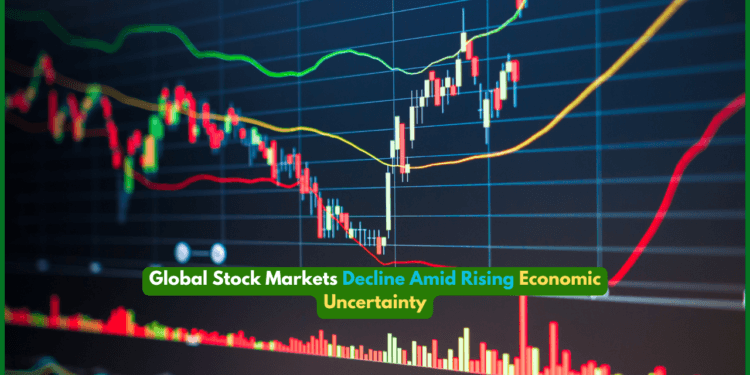Global stock markets experienced a notable downturn on March 13, 2025, as investor sentiment waned amid mounting economic concerns, including uncertainty over tariff policies and potential economic weakness. Major indices, including the S&P 500 and Japan’s Topix, saw declines, reflecting broader anxieties about the U.S. and global economic outlook, according to recent financial analyses.
The S&P 500 suffered losses in three of the last five months heading into March, dropping toward correction territory, as reported in a U.S. Bank analysis dated March 10, 2025. The decline, which saw the index retreat from record highs set in 2024, is attributed to uncertainty surrounding new Trump administration tariff policies and growing economic concerns, including a 2.8% GDP growth in 2024 that contrasts with fears of a slowdown, per the same report. The VIX, a measure of market volatility, rose into the 20+ range, signaling weaker investor sentiment, as noted by a Wall Street Journal source cited in the analysis.
Small- and mid-cap stocks, which outperformed large-cap stocks earlier in 2025, were particularly hard hit, with their slide reflecting concerns about the economy’s strength, according to U.S. Bank’s national investment strategist, Tom Hainlin. “We’re seeing the normal drawdown you see in an up market, but economic worries are amplifying the pressure,” Hainlin said.
In Japan, the Topix index fell 20% since the previous Thursday, marking its biggest three-day rout ever, driven by recession fears, worries over tech valuations, and the rapid unwind of yen-funded trades, as reported in a BlackRock analysis. U.S. stocks also slid but trimmed some losses by March 13, 2025, as investors assessed the outlook for risk assets amid these uncertainties.
Investor sentiment, broadly defined as beliefs about future cash flows and risks not justified by facts, plays a critical role in these market movements, according to the American Economic Association’s research on stock market behavior. The 2007 study by Baker and Wurgler, cited in the analysis, suggests that sentiment-driven volatility, such as current economic concerns, can lead to significant market corrections, particularly when paired with policy shifts like tariffs.
The global financial context, as outlined in the Reserve Bank of Australia’s (RBA) explanation of the 2007–2009 financial crisis, underscores the potential for economic shocks to ripple through markets. While the current situation is not as severe, the uncertainty surrounding Trump’s policy shifts on tariffs, Russia-Ukraine relations, and U.S. financial support for Ukraine has contributed to investor jitters, per U.S. Bank’s March 10, 2025, report.
Despite the downturn, BlackRock remains optimistic, suggesting that recession fears may be overblown and that risk assets could recover as concerns ease. “Consumer spending remains relatively healthy, and Q2 corporate earnings have topped expectations, with S&P 500 growth projected at 13%,” a BlackRock strategist noted, citing LSEG Datastream data. However, the rapid unwind of carry trades and geopolitical risks continue to weigh on market confidence.
As of March 13, 2025, analysts advise investors to monitor key indicators like the VIX, GDP growth, and tariff policy developments for signs of stabilization. The stock market dip reflects a cautious approach to economic uncertainty, but the potential for recovery remains, contingent on clearer policy signals and sustained economic growth.

















































